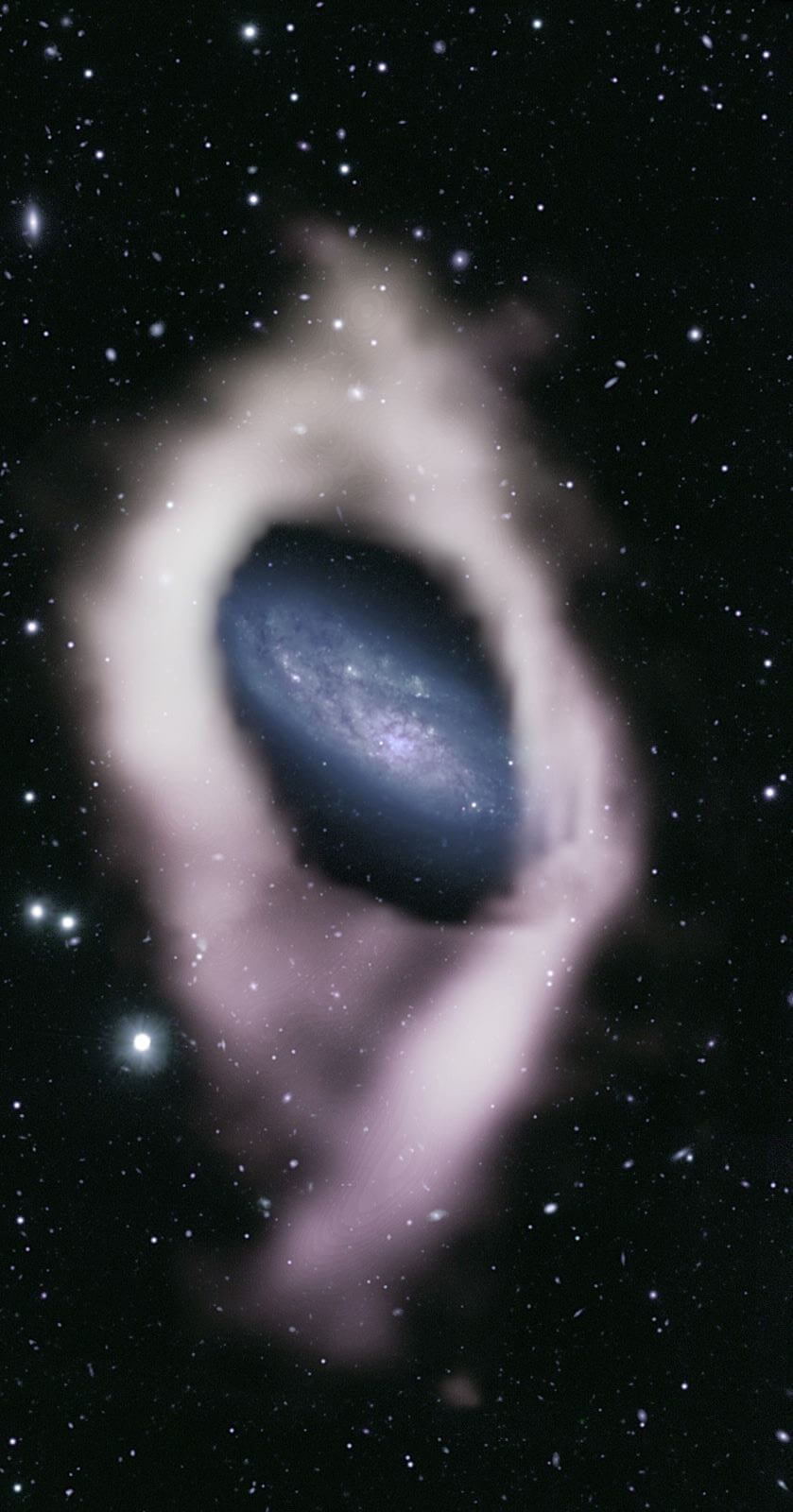This is NGC 4632, a spiral galaxy located about 56 million light-years away in the constellation Virgo. Images taken using the Hyper Suprime-Cam (HSC), a wide-field primary focus camera mounted on the Subaru Telescope at the National Astronomical Observatory of the Hawaiian Observatory of Japan, and images taken by the Australian Commonwealth Scientific and Industrial Research Organization (CSIRO).) On composite observational data from the ASKAP radio telescope of the Murchison Radio Astronomy Observatory.
[▲ThespiralgalaxyNGC4632anditsringstructuredetectedbyradiowaveswascreatedbycombiningimagesfromJapan’sSubaruNationalAstronomicalObservatoryandCSIRO’sASKAPradiotelescope(Credit:JayanneEnglish(UManitoba)NathanDeg(QueensUniversity)andWALLABYSurveyCSIRO/ASKAPNAOJ/SubaruTelescope)】[▲المجرةالحلزونية”NGC4632″وبنيتهاالحلقيةالتيتماكتشافهابواسطةموجاتالراديوتمالإنشاءمنخلالالجمعبينالصورمنالمرصدالفلكيالوطنيلتلسكوبسوبارواليابانيوالتلسكوبالراديويASKAPالتابعلـCSIRO(الائتمان:JayanneEnglish(UManitoba)،NathanDeg(جامعةكوينز)وWALLABYSurvey،CSIRO/ASKAP،NAOJ/SubaruTelescope)】
According to CSIRO, surrounding blue-glowing NGC 4632 is a ring of cold hydrogen gas captured by ASKAP. This ring structure rotates at a 90 degree angle with the galactic disk NGC 4632, and was discovered through observations conducted by a research team including Dr. Nathan Deeg from Queen’s University (Canada).
Galaxies in which a ring of stars and gas rotate at a large angle to the disk are called “polar ring galaxies,” and galaxies such as NGC 660 in the constellation Pisces are well known. According to the National Aeronautics and Space Administration (NASA), all known polar ring galaxies have been discovered through optical observations, and NGC 4632 is one of the first galaxies shown to be a polar ring galaxy by radio observations. Be one.
RELATED: ‘Polar ring galaxy’ confirmed with its own ring and large-scale explosion (May 13, 2019)
According to Professor Barbil Korybalski from CSIRO, who participated in the research, this research was carried out as part of the monitoring project “WALLABY Survey” conducted using ASKAP. Wallaby aims to detect and visualize the distribution of gas in hundreds of thousands of galaxies through observations of the entire southern sky, and in this study, we focused on two of the 600 galaxies that were the subject of small-scale observations in the early 20th century. The survey phases (NGC 4632 and NGC 6156) have been identified as candidates for polar ring galaxies. According to Degg, the results indicate that such rings may be present in 1 to 3 percent of galaxies near the Milky Way, but this percentage is lower than expected from optical observations, and appears to be higher than the percentage.
According to CSIRO, it is still unclear why the ring structures of polar ring galaxies exist, and there is a possibility that they are made of matter stripped from interacting galaxies, or that they are formed by the cosmic web.(※)It is thought that the stars may have been born during the process of creating rings of gas that flowed into the galaxy along these lines. It is expected that if ASKAP observations over the next few years discover more rare galaxies such as polar ring galaxies, we may be able to obtain clues about the nature of dark matter.
*…a large-scale, thread-like structure made up of dark matter, also known as the cosmic spider’s web.
The image was initially provided by CSIRO and NASA on September 13, 2023.
source
- Image credit: Jayanne English (U. Manitoba), Nathan Deg (Queen’s University) and WALLABY Survey, CSIRO/ASKAP, NAOJ/Subaru Telescope
- CSIRO – Astronomers reveal a cosmic bar around a rare galaxy
- NASA – NGC 4632: A hidden polar ring galaxy
- Degree et al. – WALLABY Experimental Survey: Possible polar ring galaxies NGC 4632 and NGC 6156 (MNRAS, arXiv)
Text Editing/Syrian Studies Department

“Travel maven. Beer expert. Subtly charming alcohol fan. Internet junkie. Avid bacon scholar.”







More Stories
5 peripherals that expand the possibilities of innovative PlayStation functions that upend the common sense of home gaming consoles |
5 Techniques to Use “ChatGPT” Wisely on iPhone that Can Also Be Used with Siri |
New and changed features added in ChromeOS 124 |